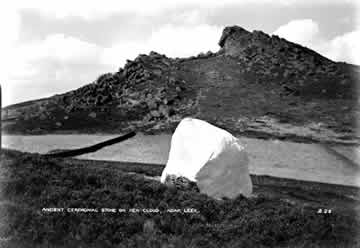
Places of Interest around the Roaches
This page contains snippets of gossip, information and legend about these places in and around the Roaches......
- Lud Church - a chasm 15m deep
- Stone Carving - an enigmatic object near the Trig point
- The Winking Man - weird rock formation
- Dains Mill - a refurbished water mill built in 1602
- Apprentice Hut - a building of large stones from the quarrying days
- Queen's Chair - a rock carved into a chair
- Derelict Farm Roachend - ruins of a farm with history
- Hanging Stone - Outcrop of Rock with inscriptions
- Derelict Cottage Roach Rd - Old cottage by the car parks
- The Bawdstone - A revered boulder with healing powers!
Lud Church
Lud Church is a chasm about 15m(50ft) deep and about 100m long. see Walk1. There are many legends linked with Lud Church but it does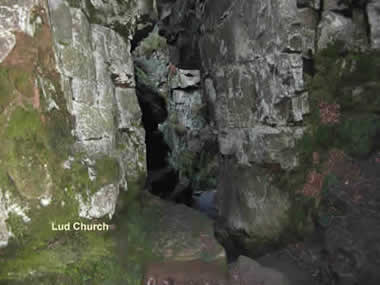 seem that it was associated with the Lollards.
The Lollards were the first recognised critics of the established
church since the Fifth Century” according to historian, Mike Ibeji.
"They were founded by John Wyclif, in the 1370s, and quickly found
themselves victims of persecution from the Catholic Church, and the monarchy.
In 1410, Henry IV gave royal assent to a statute which legitimised the
burning of heretics, 'De haeretico comburendo'; the Lollards were victims
of this aggression, because of their radical policies. Their belief that
the Catholic Church was corrupt threatened the privileged position enjoyed
by the priests and monasteries of England."
seem that it was associated with the Lollards.
The Lollards were the first recognised critics of the established
church since the Fifth Century” according to historian, Mike Ibeji.
"They were founded by John Wyclif, in the 1370s, and quickly found
themselves victims of persecution from the Catholic Church, and the monarchy.
In 1410, Henry IV gave royal assent to a statute which legitimised the
burning of heretics, 'De haeretico comburendo'; the Lollards were victims
of this aggression, because of their radical policies. Their belief that
the Catholic Church was corrupt threatened the privileged position enjoyed
by the priests and monasteries of England."
Read more on the BBC website. Lollards
"About 1862 the landowner, Philip Brocklehurst of Swythamley, in Heaton, placed a ship's figurehead in the
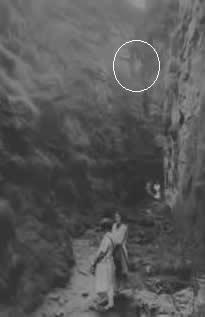 form of a woman at the entrance of the ravine.
It was apparently intended to commemorate the supposed martyrdom of the
daughter of a Lollard preacher, and it was still there in 1914."
form of a woman at the entrance of the ravine.
It was apparently intended to commemorate the supposed martyrdom of the
daughter of a Lollard preacher, and it was still there in 1914."From: 'Leek: Leekfrith', A History of the County of Staffordshire: Volume 7: Leek and the Moorlands (1996), pp. 191-202. URL: http://www.british-history.ac.uk/report.asp?compid=22915.
As can be seen from this picture, which was taken in 1930, the figurehead was still there but moved up into a niche in the rock face. There have been reports from the 1960's of the figurehead rotting in the mud at the bottom of the chasm. So in all it was there for about 90-100 years. I wonder how long a similar object would last if it was put in there today?
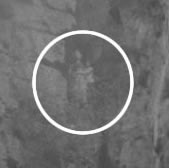
The person hugging the figurehead in the picture is a relative of the photographer.
This picture was provided by Rose Robinson
The sun doesn't get far into Lud's Church. This is evidenced by snow being taken from Lud's Church down to Leek Marketplace on the 17th July and that there were a hundred bags more if people wanted it, this was prior to 1696 as it is noted in Chapter 4 par 41 of The Natural History of Staffordshire by Robert Plot (1696).
There is conjecture that Lud Church may be the setting, "the Green Chapel", of the epic Arthurian poem from the 1400s "Sir Gawain and the Green Knight". This poem is on a single manuscript and was not rediscovered until the 1800s. The poet is unknown but it is written in a dialect which places him in the vicinity of Leek and could have been a monk at the, now ruined, Dieulacres Abbey at Abbey Green on the northern outskirts of Leek, Staffordshire.
You can read more about the poem here and here.
There was a televison programme about the poem presented by Simon Armitage, who has written a book on the poem.
Stone Carving
 sm.jpg) A stone carving has recently been revealed on Roach Ridge about
2 minutes walk or 200metres to the south of the Trig Point. Until a couple of years
ago it was hidden under a blanket of heather, but the wind blew the growth
back and the carving was rediscovered in 2004. (Click image to enlarge).The carving is very close to the edge of a cliff and consists of an area about 3 metres by 2 metr es which has been levelled. A 36inch diameter circle has been carved in the middle of the levelled area. In the centre of the circle is a carved cup shape. Stoke Archaeology Society have put forward the idea that this is perhaps a mill-stone in the making. To release the stone the mason would have to cut out underneath. It seems a pretty inaccessible place to fashion a millstone being almost as high as you can go and part-made millstones can be found in the quarries much further down the valley.
These millstones are made from boulders which seems to be a much less arduous and obvious way of making them.
A stone carving has recently been revealed on Roach Ridge about
2 minutes walk or 200metres to the south of the Trig Point. Until a couple of years
ago it was hidden under a blanket of heather, but the wind blew the growth
back and the carving was rediscovered in 2004. (Click image to enlarge).The carving is very close to the edge of a cliff and consists of an area about 3 metres by 2 metr es which has been levelled. A 36inch diameter circle has been carved in the middle of the levelled area. In the centre of the circle is a carved cup shape. Stoke Archaeology Society have put forward the idea that this is perhaps a mill-stone in the making. To release the stone the mason would have to cut out underneath. It seems a pretty inaccessible place to fashion a millstone being almost as high as you can go and part-made millstones can be found in the quarries much further down the valley.
These millstones are made from boulders which seems to be a much less arduous and obvious way of making them.I've been doing more research on this carving firstly by consulting Archeologists John Barnett and Adam Russell - the former of the Peak Park - who are pretty sure the stone carving pictured is not a mill stone in the making but could possibly be where a Victorian telescope was mounted.
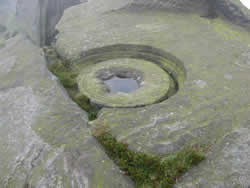 Irene Kirkpatrick, a local historian, has found a reference to the carving in Sir Philip Brocklehurst's book 'Swythamley and It's Neighbourhood' published in 1874. This is the reference "a few yards from the rocking stone is a circular cutting, level with the ground, about which many conjectures have been raised: it is in the solid rock, but why or wherefore it was made is still a mystery."
Irene Kirkpatrick, a local historian, has found a reference to the carving in Sir Philip Brocklehurst's book 'Swythamley and It's Neighbourhood' published in 1874. This is the reference "a few yards from the rocking stone is a circular cutting, level with the ground, about which many conjectures have been raised: it is in the solid rock, but why or wherefore it was made is still a mystery."So if nothing was known in living memory in 1874 of the origins of the carving then this puts the origin at least a lifetime earlier perhaps more, ie to before 1800.Telescopes were around in the 1700's so it could still be a telescope mounting, however it is unlikely to be Victorian.
The Winking Man
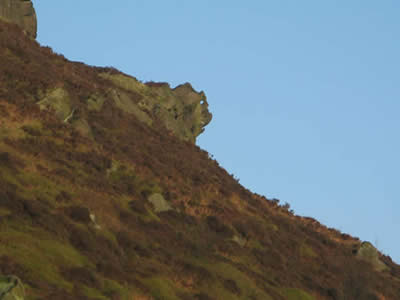
This weird rock formation can be seen from the Leek- Buxton road (A53) about 5miles outside Leek. It is part of Ramshaw rocks. It looks like a face sticking out of the hillside. As you travel past in a car the 'eye' appears to wink as a pinacle of rock passes behind the face as a consequence of parallax.
You can get to the rock formation by driving from Leek towards Buxton on the A53. After about 3 miles you pass through Blackshaw moor with the Threehorseshoes Inn on your left. Continue on up the steep hill known as Cat Torr, when the gradient eases you come to a house on the left which used to be a toll point - turn left here. Park sensibly towards the top of the hill. Walk across the heath under the rocks parallel with the A53 until you reach the Winking Man.
Dains Mill
This mill (see walk3) was a corn and flour mill powered by water from the Roaches and Ramshaw. The building which has been painstakingly restored became a mill in circa 1600 - there are records back to this time. Previously it had been associated with a religious order and possibly dates back to 1100. The mill was refurbished in 1800 and the present owners family took possession in 1802 and for six generations it turned out flour, porridge oats and animal feed until 1946 when a thunderstorm burst the damn around one of the ponds, while the owner/operator was in hospital. No-one opened the sluice gates to protect the pond. The tall building in the picture here was the drying rooms. It was three stories high but access to each level was possible from the hill at the back of the building. The lower level was a fire room with a steel floor above where the grain was dried.After 1946 the mill fell into disrepair and became a very sorry sight. Between 2004 and 2006 a costly and painstaking refurbishment has been effected. Further development is planned to make a "green" holiday centre for example using the water wheel to provide about 2kw of electicity and heat pumps upgrading heat from the mill stream.
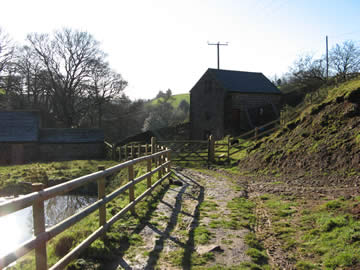 Below is a quote from A History of the County of Stafford: Volume 7:
Below is a quote from A History of the County of Stafford: Volume 7:
"In the late 1560s Thomas Gent of Upper Hulme built
a mill on Back brook, upstream from Hulme mill. In 1599 there was a complaint
from the owners of Hulme mill that Gent's mill took water from their mill
and drew some of its trade, (fn. 9) and Gent's mill was evidently demolished.
In 1600 his grandson William Gent let the site to two brothers, John and
William Hind, and the mill had been rebuilt by 1602. (fn. 10) The tenant
in 1610 was Robert Deane, (fn. 11) and the mill was known in the 18th
century as Deans (later Danes or Dains) mill. (fn. 12) It stopped working
c. 1946. (fn. 13)"
From: 'Leek: Leekfrith', A History of the County
of Stafford: Volume 7: Leek and the Moorlands (1996), pp. 191-202. URL:
http://www.british-history.ac.uk/report.asp?compid=22915&strquery=meerbrook.
Date accessed: 16 February 2007.
Access to the mill can be made on foot from the ford at Upperhulme by walking up the steep concrete track between the Old smithy and Brook Cottages. Please
park away from the village as access to the factories is required often
with large vehicles.
Apprentice's Hut
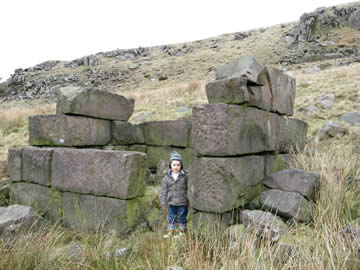
On access land on the north west slopes of the Roaches is an artifact of the quarrying which was a major industry in the valley. This small building - now with no roof- is thought to be a workman's hut and also to be an exercise for the apprentices who were being educated at the quarry. Within living memory the roof was still on and of heather.
The slabs of stone involved are huge and it makes you wonder how the lads lifted and moved them without the assistance of machines.
My grandson thinks the hut was built by trolls who else would be able to lift such heavy weights!!
The Queen's Chair
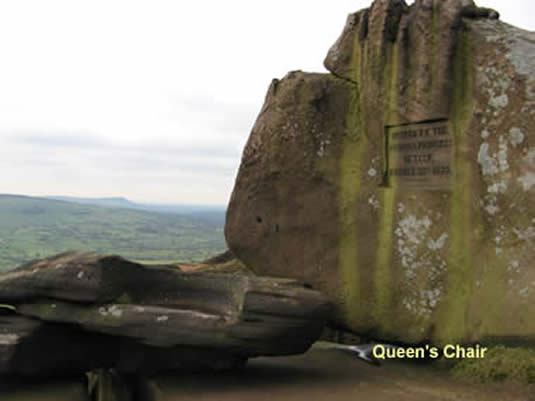 The Queens Chair is a seat hewn out of a boulder precariously set
on the edge of a cliff above Rock Hall. Above the seat is a plaque carved
in the rock declaring that the Prince and Princess of Teck visited this
site on Aug 23rd 1872..
The Queens Chair is a seat hewn out of a boulder precariously set
on the edge of a cliff above Rock Hall. Above the seat is a plaque carved
in the rock declaring that the Prince and Princess of Teck visited this
site on Aug 23rd 1872..Sir Phillip Brocklehurst of Swythamley invited the royal pair. The Prince was a minor german aristocrat and the Princess was the mother of Queen Mary wife of George V of England.
The following are extracts from "Answers.com" on the life of the Princess
By the age of 30, Mary Adelaide (as
she was known) was still unmarried. 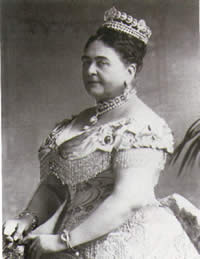 Her unattractive appearance
and lack of income were contributing factors, as was her advanced age.
However her royal rank prevented her marrying someone not of royal blood.
Her cousin Queen Victoria took pity on her, and attempted to arrange pairings.
Her unattractive appearance
and lack of income were contributing factors, as was her advanced age.
However her royal rank prevented her marrying someone not of royal blood.
Her cousin Queen Victoria took pity on her, and attempted to arrange pairings.
Eventually a suitable candidate was found in Württemberg, Prince
Francis, Prince of Teck. The Prince was of lower rank than Mary Adelaide, and was also the product
of a morganatic marriage and had no succession rights to the throne of
Württemberg, but was at least of princely title and of royal blood.
However with no other options available, Mary Adelaide decided to marry
him. The couple were married on 12 June 1866, at Kew Church, Surrey.
Despite their modest income, Mary Adelaide had expensive tastes and lived
an extravagant lifestyle of parties, expensive food and clothes, and holidays
abroad. The debts soon built up and the Tecks were forced to flee the
country in 1883 to avoid their creditors.
The Tecks returned from exile in 1885 and continued to live at White Lodge
in Richmond. Mary Adelaide began devoting her life to charity, serving
as patron to Barnardo's and other children's charities.
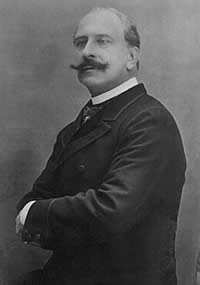 In 1891, Mary Adelaide was keen for her daughter, Princess Victoria Mary
of Teck (known as May) to marry one of the sons of the Prince of Wales,
the future King Edward VII. On the other hand, Queen Victoria wanted a
British-born bride for the future king, though of course from royal rank
and ancestry - and not some "lowly" noblewoman. Mary Adelaide's
daughter fulfilled the rank criteria. After Queen Victoria's approval,
May became engaged to the second in line to the British throne, Prince
Albert Victor, Duke of Clarence. The death of the Duke of Clarence only
six weeks later looked like a cruel blow. However, Queen Victoria was
fond of Princess May and persuaded the Duke of Clarence's brother, and
next in the line of succession, Prince George, Duke of York to marry her
instead. (He became George V)
In 1891, Mary Adelaide was keen for her daughter, Princess Victoria Mary
of Teck (known as May) to marry one of the sons of the Prince of Wales,
the future King Edward VII. On the other hand, Queen Victoria wanted a
British-born bride for the future king, though of course from royal rank
and ancestry - and not some "lowly" noblewoman. Mary Adelaide's
daughter fulfilled the rank criteria. After Queen Victoria's approval,
May became engaged to the second in line to the British throne, Prince
Albert Victor, Duke of Clarence. The death of the Duke of Clarence only
six weeks later looked like a cruel blow. However, Queen Victoria was
fond of Princess May and persuaded the Duke of Clarence's brother, and
next in the line of succession, Prince George, Duke of York to marry her
instead. (He became George V)
The marriage of May into the top rankings of the royal family, led to
a dramatic revival in the fortunes of the Tecks, with their daughter one
day to be Queen consort. Unfortunately Mary Adelaide never saw her daughter's
coronation as Queen. Mary Adelaide died on 27 October 1897 at White Lodge,
Richmond Park, Surrey, and was buried in the royal vault at St. George's
Francis(the Prince of Teck) died on January 21, 1900 at White Lodge[3].
He was buried next to his wife in the Royal Vault at St. George's Chapel,
Windsor.
This is an actual photo from 1872 recording the visit of the Teck's to the Roaches. To enlarge click on the image. See also this entry in "The Graphic" magazine from 1872.
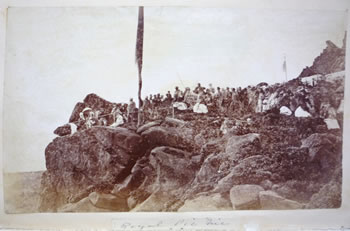
Higher Roachend Farm
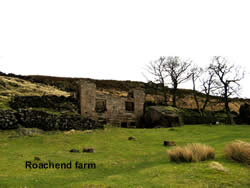 Higher Roachend Farm at
Roachend is a rather unusual derelict cottage. (Take care
it does not look too safe).
If you stand at the cattle grid across the road looking towards Tittersworth
reservoir, to your left you will see a delapidated barn. From this barn
you can see the cottage. It is unusual because it has the shippon where
the cows were kept underneath the house. This had the great advantage
that it heated the house in winter because cows give off an incredible
amount of heat. This property is at 1500ft so this layout would be a distinct
advantage. The smell would be pretty bad though.
Higher Roachend Farm at
Roachend is a rather unusual derelict cottage. (Take care
it does not look too safe).
If you stand at the cattle grid across the road looking towards Tittersworth
reservoir, to your left you will see a delapidated barn. From this barn
you can see the cottage. It is unusual because it has the shippon where
the cows were kept underneath the house. This had the great advantage
that it heated the house in winter because cows give off an incredible
amount of heat. This property is at 1500ft so this layout would be a distinct
advantage. The smell would be pretty bad though.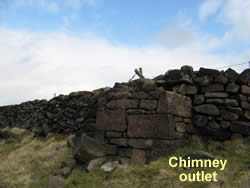 The cows did not provide all the heat however because the story goes that
the coal fire smoked very badly, which is not unusual for houses located
under the lip of a hill. It was so bad that that the resident -a Mr Kirkham-
decided to solve the problem by hand digging a trench up the field to
the back left of the building up to the wall at the top of the field.
He lined the trench with stone flags to make a pipe and back filled the
trench. He built an outlet into the dry stone wall. Come the day to try
the fire using his new chimney the fire smoked just as badly!! However
all was not lost when the chimney warmed up it did work, but he had to
keep a fire going 24 hours a day or it would cool down and smoke again.
The outlet can still be seen in the wall above the house.
The cows did not provide all the heat however because the story goes that
the coal fire smoked very badly, which is not unusual for houses located
under the lip of a hill. It was so bad that that the resident -a Mr Kirkham-
decided to solve the problem by hand digging a trench up the field to
the back left of the building up to the wall at the top of the field.
He lined the trench with stone flags to make a pipe and back filled the
trench. He built an outlet into the dry stone wall. Come the day to try
the fire using his new chimney the fire smoked just as badly!! However
all was not lost when the chimney warmed up it did work, but he had to
keep a fire going 24 hours a day or it would cool down and smoke again.
The outlet can still be seen in the wall above the house.
There's some pretty old graffiti too!
Hanging Stone
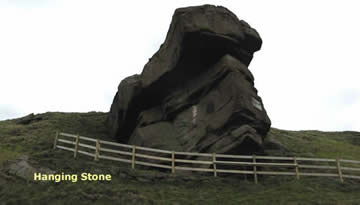 Hanging Sone is a precarious rock outcrop on Back Forest Ridge
overlooking Swythamley Hall, which was the home of the Brocklehurst family
who owned the Roaches estate until the death of the last in line in 1978.
You can get to Hanging Stone along back Forest Ridge see walk
4
Hanging Sone is a precarious rock outcrop on Back Forest Ridge
overlooking Swythamley Hall, which was the home of the Brocklehurst family
who owned the Roaches estate until the death of the last in line in 1978.
You can get to Hanging Stone along back Forest Ridge see walk
4
The Rock is extra special not just for it's weird aspect but because it has two inscriptions one for a much loved dog and the other for Lt Col Courtney Brocklehurst - the man responsible for the presence of the wallabies on the Roaches.
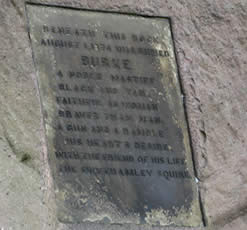
The inscription for the dog is professionally carved into the rock and
says ---
August 1st 1874 was buried
BURKE a noble mastiff black and tan
faithful as woman
braver than man
a gun and a ramble
his hearts desire
with the friend of his life
the Swythamley squire"
The squire obviously loved his dog!
The other inscription is a plaque with an epitaph to the Lt Colonel and a poem in the handwriting of Courntney's brother Philip Brocklehurst. The inscription reads---
LT COL HENRY COURTNEY BROCKLEHURST 10TH ROYAL HUSSARS
AND PILOT IN THE ROYAL FLYING CORPS 1916-1918
GAME WARDEN OF THE SUDAN
BORN AT SWYTHAMLEY MAY 27TH 1888
KILLED ON ACTIVE SERVICE IN BURMA
ON COMMANDO JUNE 1942
"Horses he loved and laughter,
the sun, with spaces and the open air.
The trust of all dumb living things he won and never knew the luck too
good to share.
His were the simple heart and open hand and honest faults he never strove
to hide.
Problems of life he could not understand but as a man would wish to die,
he died.
Now though he will not ride with us again, his merry spirit seems our
comrade yet,
Freed from the power of weariness and pain, forbidding us to mourn or
to forget....
Erected by his devoted brother 1949"
Obviously Courtney was an adventerer as was his brother Philip. Unfortunately the epitaph to the dog looks as though it will outlast that of the soldier even with the 75 year head start.
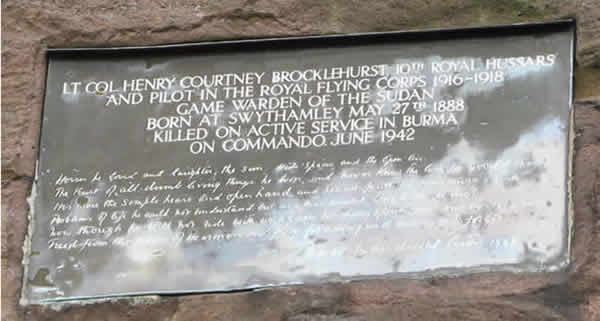
Mount Pleasant
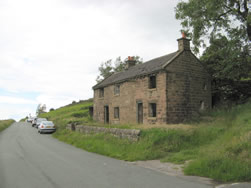 Mount Pleasant was the derelict cottage on Roach Rd by the parking areas. It had been
unoccupied since the 1970's. There had been no electricity supply.
It did not get up to many of these parts until the late 1960's.
Mount Pleasant was the derelict cottage on Roach Rd by the parking areas. It had been
unoccupied since the 1970's. There had been no electricity supply.
It did not get up to many of these parts until the late 1960's.Many people have wandered round this wreck over the years dreaming of living in a cottage in the country or perhaps opening a tea room. For many years it was not for sale.
The owner has been offered very tempting sums from time to time but was adamant the cottage remained as it was.
However the owner died and the wreck went up for sale by auction -15th July 2008. Guide price £40,000. Agents Whittaker and Biggs Leek.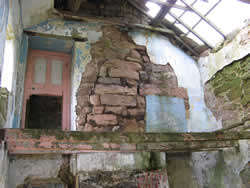
The property went for £122,000!!! - this is with no water, electric or land and a fight with the Peak Park as reoccupation will be subject to planning permission. At the same auction a livable stone cottage with a barn down the road in UpperHulme went for only £190,000.
The Mount Pleasant has now been renovated and is now a holiday cottage.
The Bawdstone
The Bawdstone is a boulder balanced on three rocks situated between Hen Cloud and the Roaches. The Bawdstone could be man made - a dolmen. It certainly has a history. It is thought toThe stone is located at 53.154852deg latitude, -1.989527deg longitude. Directions-take the path from Roaches gate to Hen Cloud after about 300m go through the gate in the wall with Hen cloud facing you. Go across the field and through the next gate. The Bawdstone is to your left about 50m away.